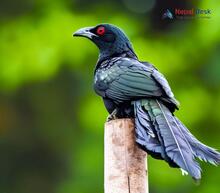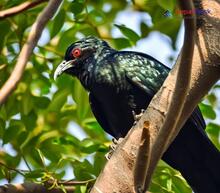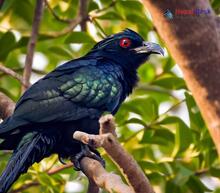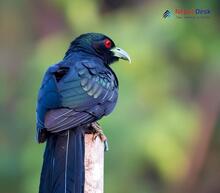Nepal, a country nestled in the heart of the majestic Himalayas, is renowned for its rich biodiversity and natural beauty. From snow-capped peaks to dense forests, Nepal offers an abundance of habitats for a wide range of species. One such fascinating group of birds calls this diverse ecosystem their home – the Eudynamys genus, also known as the Koels or Cuckoos.
The Eudynamys genus comprises several species of cuckoos that are native to Asia and Australia. These elusive birds possess striking features and exhibit unique behaviors, making them an intriguing subject for wildlife enthusiasts in Nepal. In this blog post, we'll delve into the captivating world of the Eudynamys and explore their characteristics as well as their significance to Nepalese ecosystems.
Distinctive Features
The birds from the Eudynamys genus are known for their distinctive appearance and enchanting call. The males generally boast glossy black plumage while females have a more mottled coloration with dark brown and white spots or streaks. Their long tails and slender bodies make them adept at navigating through trees in search of prey.
Perhaps one of the most intriguing aspects of these birds is their iconic call. The loud, melodic song of the Asian Koel has served as a harbinger of spring for countless generations and holds cultural significance across many regions in Nepal.
Cuckoo Behavior
Eudynamys species are brood parasites – they lay their eggs in nests belonging to other birds. Instead of building their own nests, they cunningly evade typical parental duties by relying on other bird species to raise their young. This sneaky behavior allows them to focus on mating while letting other birds expend energy nurturing their offspring.
Ecological Significance
Cuckoos from the Eudynamys genus play a critical role in maintaining the ecological balance within Nepal's diverse habitats. As natural predators of insect pests, they help control populations of insects that can be detrimental to agriculture and vegetation. This aids in the preservation of Nepal's delicate ecosystems by promoting a healthy balance between flora and fauna.
Conservation and the Future
Despite their resilience and cunning nature, members of the Eudynamys genus face several threats to their survival. The degradation and fragmentation of their natural habitats due to human encroachment pose significant challenges. Fortunately, conservation initiatives are being implemented to protect these iconic birds and other native wildlife in Nepal.
Embracing ecotourism, engaging local communities in conservation efforts, and educating the public about the importance of preserving Nepal's unique biodiversity are all critical steps towards ensuring a sustainable future for the Eudynamys genus among other native species.
In conclusion, the Eudynamys or Koels are fascinating birds that not only contribute to Nepal's rich biodiversity but also serve as sentinels of ecological health within their habitats. Fostering an appreciation for these captivating creatures and understanding their ecological importance should encourage further conservation efforts to protect Nepal's ecosystems for generations to come.




